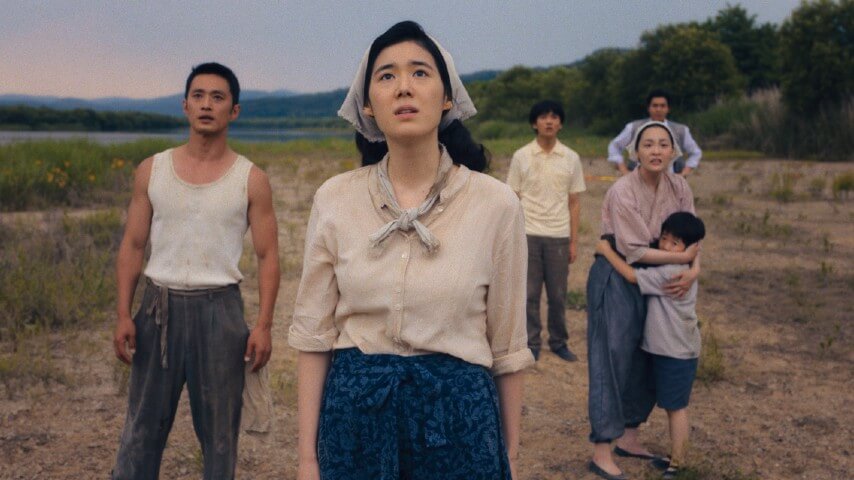Pachinko, Apple TV+’s unsung hero, makes a remarkable return
In its second season, the saga continues to feel both expansive and intimate
Sungkyu Kim, Eunchae Jung, and Minha Kim in Pachinko (Photo: Apple TV+)
Pachinko’s beauty lies in its attention to detail. This is a TV show determined to utilize its visual space completely, so the camera purposefully lingers on facial expressions and landscapes, finding meaning in mundane chores like cooking, eating, and driving. It makes Apple TV+’s drama inherently immersive, a necessity because the show jumps across years, viewpoints, languages, and countries. In season two, which premieres August 23, Pachinko courses through both the Japanese countryside during World War II as well as the crowded Osaka streets of 1989. Still, the sweeping perspectives don’t detract from its emotional core or universal appeal.
Created by Soo Hugh and based on Min Jin Lee’s novel of the same name, the series returns for eight compelling hourlong episodes that teem with melancholy and exultation, capturing the duality of life. It’s an authentic tale of persisting while facing hardships and finding unexpected joy and freedom in moments of grief and loss. Sure, all of this might sound preachy, but Pachinko succeeds in delivering this without being didactic. That’s because, much like its debut run, season two is a pretty perfect blend of a soulful scripts and performances.
Since it premiered back in early 2022, here’s a quick refresher: Pachinko primarily follows Sunja, a young Korean woman (played by Kim Min-ha) who immigrates to Japan in the late 1930s after marrying a Protestant minister. A mother of two in unfamiliar territory, she strives to take care of her family amid poverty, racism, and political turmoil. The show also tracks an older Sunja (portrayed by Youn Yuh-jung) in 1989 as she comfortably lives with her grown son, who owns an arcade of pachinko, a popular gambling device.
The series continues to go back and forth in time to depict her life through nuanced cultural insights, especially via food. Sunja earns money by selling kimchi and noodles in the market after moving to Osaka. Later in season two, she works in a rice field. The camera beautifully captures her process and also spends time with her family as they sit together to eat meals, often under soft lighting that contrasts the dreary war going on outside the comfort of their home. In 1989, Sunja prepares the same traditional cuisine to display her affection for and reconnect with her adult grandson, Solomon (Jin Ha).
Season two jumps to 1945, when Sunja, her two sons, and sister-in-law, Kyunghee (Jung Eun-chae), take refuge away from the city as the war ravages Japan. She gets help from her former lover, Koh Hansu (Lee Min-ho), a wealthy man with ties to the criminal world. It’s a riveting timeline because it’s invested in nurturing various relationships, none more so than Sunja and a teen Noa (played by Kang Soon Kim at age 14 and Tae Ju Kang at age 19). A studious and moral boy, Noa’s goal is to attend a prestigious university; his mother’s is to help him achieve it. And their interactions, in turn, are laced with heartfelt emotion. (We’re not spoiling the source material here, but their bond takes center stage and also sets up season three.)
That said, the show slightly fumbles with its non-linear narrative when it dwells on Solomon. A Yale-graduated banker, he moves back to Japan for a deal that fails. His attempts to recover from the mess in season two lead to an ethical dilemma and some distance from his grandmother. It’s an interesting parallel to how virtuously Sunja attempted to raise her sons in the past, but the execution of the 1989 timeline gets a tad tedious. And that’s despite an excellent turn from Minari’s Yuh-jung and an expanded role for Shōgun’s Anna Sawai, who plays Solomon’s coworker and love interest, Naomi.
Pachinko has a terrific cast, which includes new performers like Sungkyu Kim as Hansu’s right-hand man and the kid actors playing Noa and Mozasu. Meanwhile, Min-ho is exceptional as a stoic Hansu, fighting to keep his feelings for Sunja at bay and dealing with his horrible past actions. It’s a welcome chance for him to depict his range beyond the romantic heroes he often plays in K-dramas. Eun-chae gets a bigger spotlight, too, and damn if she doesn’t shine as Kyunghee, who faces her own moral dilemma when sparks fly with a man who isn’t her husband. But the undisputed backbone here remains Kim Min-ha. She embodies Sunja with such care and subtlety, not needing too much dialogue to convey her character’s experiences because her evocative expressions do the job. And when she does deliver the words, it happens with conviction. Season two lets her grapple with Sunja’s identity in far more complex ways after her reunion with Hansu, and Min-ha rises to the occasion. It’s honestly impossible to look away when she’s onscreen.
Aside from the acting, which grounds Pachinko in its few weak moments, the show also boasts Ruth Ammon’s sweeping production design, Kyunghwa Chae’s fantastic costumes, and a real sense of aliveness thanks to directors of photography Ante Cheng and Sofian El Fani. What’s more, the writing skillfully toggles between Japanese, Korean, and English, and directors like Arvin Chen, who helms season two’s best installments (including a triggering episode five partially set during the atomic bombing of Nagasaki), immerse us into these times and places. All of these elements combine for a poignant viewing experience.
Pachinko’s expansive saga feels intimate because it distills historic events through the lens of one woman and her loved ones. What is the impact of a global catastrophe on the day-to-day lives of the people who live through it? It’s a big question that Pachinko masterfully tries to answer.
Pachinko premieres August 23 on Apple TV+